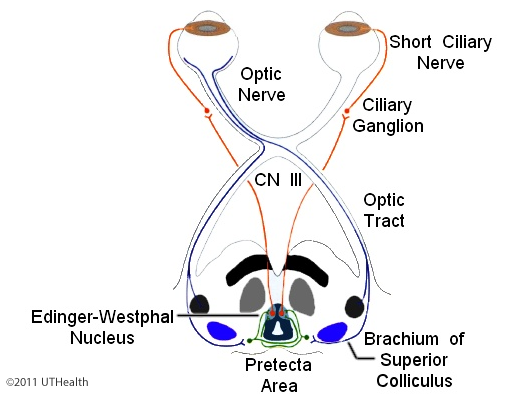Lab 8 (ƒ7) - Visual System
Supranuclear Control of Pupil Size and Lens Shape
Topics covered:
- Pupillary light reflex
- Pupillary andquot;darkandquot; reflex
- Pupillary accommodation response
- Lens accommodation response

Pupillary light reflex: When light falls on the retina of one eye, the pupils of both eyes will constrict in a consensual pupillary reaction. The afferent arm of the reflex pathway includes retinotectal fibers in the optic nerve and tract: that is, retinal ganglion cells' axons that travel in the brachium of the superior colliculus to terminate in the pretectal area. The axons of the pretectal neurons decussate partially in the posterior commissure and in the periaqueductal gray anterior to the aqueduct to terminate bilaterally in the Edinger-Westphal nucleus. Recall the Edinger-Westphal (preganglionic) neurons send their axons in the oculomotor nerve to the ciliary ganglion and that it is the postganglionic fibers in the short ciliary nerve that innervate the iris sphincter muscle. Because the visual and pretectal inputs are bilateral to each Edinger-Westphal nucleus (i.e., in the optic tract and posterior commissure), the reflex is consensual (both pupils contract when light falls on one eye).
Pupillary andquot;darkandquot; reflex: When the light falling on both retinas is removed, the pupils of both eyes will dilate to increase the total amount of light entering the eyes. Some optic nerve fibers travel to and terminate in the hypothalamus. Presumably, the hypothalamic neurons send their axons to structures that influence the activity of the lateral horn (preganglionic sympathetic) cells in upper thoracic spinal cord. The preganglionic sympathetic axons, in turn, travel to and end on sympathetic ganglion cells that control the dilator muscle of the iris.
Pupillary accommodation response: The third type of pupillary response is the accommodation or near point response (pupil constriction) which accompanies the convergence of the eyes and lens accommodation during near vision. The near point reaction of the pupil involves (1) the visual pathway, (2) the parieto-occipital visual association areas, and (3) the supraoculomotor area. The neurons in the supraoculomotor area project bilaterally to the Edinger-Westphal nucleus. Because the supranuclear control of the two pupillary constrictor responses differ (i.e., pretectal area for light reflex and supraoculomotor for accommodation), it is possible to have a lesion which interferes with the pupillary light reflex but maintains the pupillary response in near vision (i.e., the Argyll Robertson pupil with bilateral damage to the pretectal area) or vice versa.
Lens accommodation response: The pathway involved is identical to that of the pupillary accommodation response: that is, visual association cortex to supraoculomotor area, to Edinger-Westphal nucleus, to ciliary ganglion, and to the ciliary muscles via the short ciliary nerve. During the near point response, the contraction of the ciliary muscles decreases the tension on the suspensory ligaments which releases the tension on the lens capsule. The lens becomes more convex with its anterior pole shifted more anteriorly. The result is an increase in the refractive properties of the lens so that the image of the object of view is in focus on the fovea of the retina.
